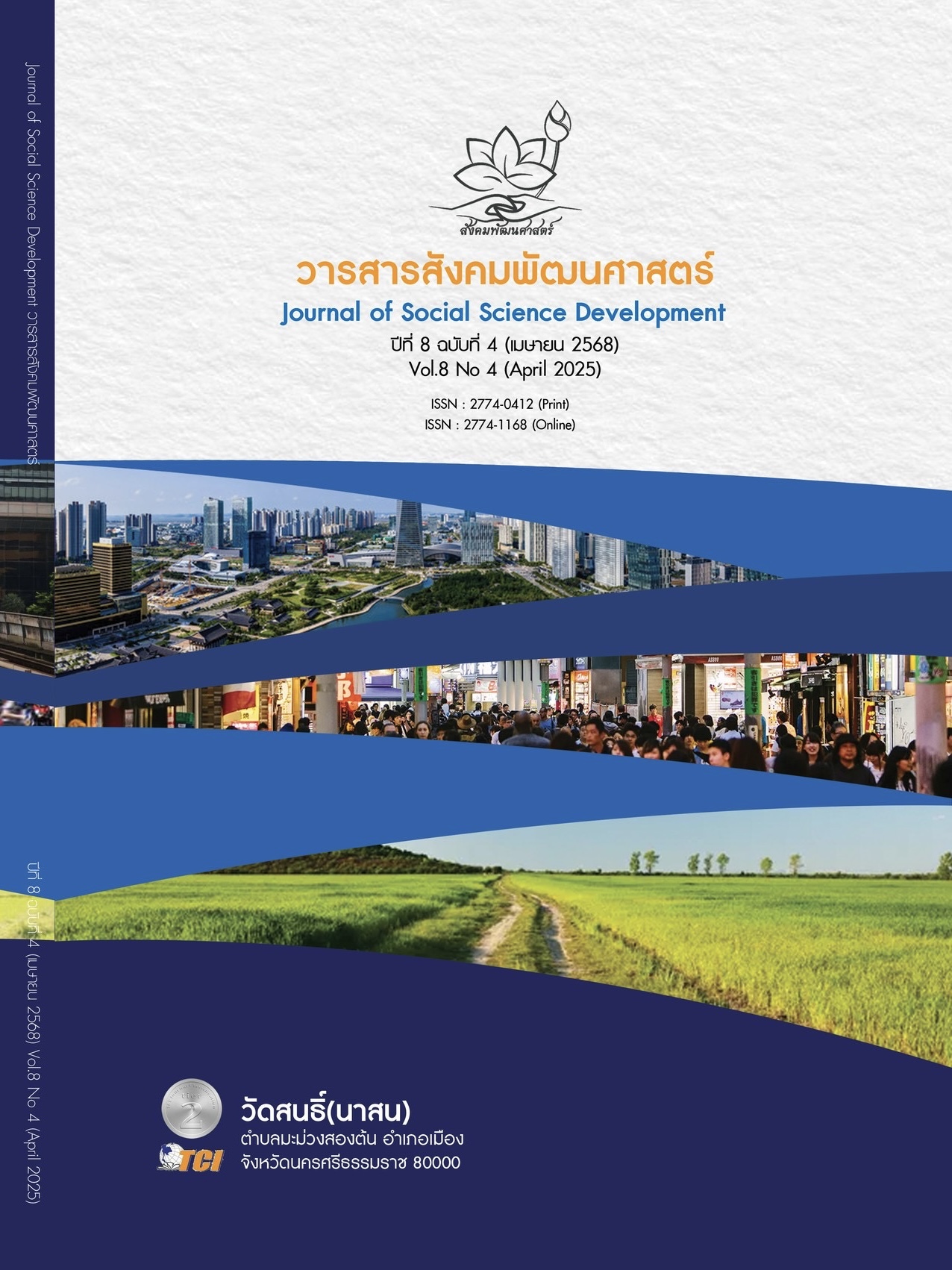SOCIAL ECOLOGY FOR ENVIRONMENTAL MANAGEMENT OF MANGROVE FORESTS IN PAK PHUN SUBDISTRICT NAKHON SI THAMMARAT PROVINCE, THAILAND
Main Article Content
Abstract
This research article aimed to 1) Analyze the existing problems in mangrove environmental management and 2) Propose guidelines for mangrove environmental management. It was a qualitative research study. Key informants included representatives from local administrative organizations, local leaders, eco-tourism businesses and community enterprises, educational institutions, and the private sector. A total of 40 participants were purposively selected. Data was collected through in-depth interviews and focus group discussions, using interview guides and observation record forms as research tools. The data were analyzed using content analysis and summarized descriptively. The research findings revealed that: 1) The problems in mangrove environmental management included degradation due to improper land use, urban expansion, tourism, agriculture, and pollution-especially from shrimp farms and factories-which led to the deterioration of water and soil quality. Waste discarded by communities and tourists also negatively impacts the ecosystem. Coastal erosion caused by sea waves and community activities posed a serious issue that required cooperation from all sectors and clear public policies to regulate land use, waste discharge, mangrove rehabilitation, and community participation in mangrove environmental management; and 2) The proposed guidelines for mangrove environmental management involved raising awareness and understanding of the importance of mangroves to community life and the economy. The study also emphasized the need to build strong stakeholder networks and support policies for effective mangrove environmental management. Coordination and collaboration among networks and local communities were encouraged, along with creating commitments for cooperation and knowledge sharing, budget allocation, and network technical support. These efforts aimed to strengthen relationships and enhance sustainable mangrove environmental management capacity.
Article Details

This work is licensed under a Creative Commons Attribution-NonCommercial-NoDerivatives 4.0 International License.
References
กองอนุรักษ์ทรัพยากรป่าชายเลน. (2565). คู่มือการปลูกป่าชายเลน เพื่อประโยชน์จากคาร์บอนเครดิต พ.ศ. 2565. กรุงเทพมหานคร: กองอนุรักษ์ทรัพยากรป่าชายเลน, กรมทรัพยากรทางทะเลและชายฝั่ง.
จำลอง โพธิ์บุญ. (2555). การมีส่วนร่วมของชุมชนในการจัดการทรัพยากรธรรมชาติและสิ่งแวดล้อม. วารสารการจัดการสิ่งแวดล้อมและความยั่งยืน, 3(1). 141-174.
ณัธท์ณริน พูลสวัสดิ์. (2557). ความตระหนักของประชาชนท้องถิ่นในการอนุรักษ์ทรัพยากรป่าชายเลน ศึกษากรณี ตำบลโคกขาม อำเภอเมือง จังหวัดสมุทรสาคร:ความตระหนักของประชาชนท้องถิ่นในการอนุรักษ์ทรัพยากรป่าชายเลน ศึกษากรณี ตำบลโคกขาม อำเภอเมือง จังหวัดสมุทรสาคร. วารสารสังคมศาสตร์บูรณาการ มหาวิทยาลัยมหิดล, 1(2), 57-82.
เทศบาลเมืองปากพูน. (2566ก). หน้าหลัก. เรียกใช้เมื่อ 21 พฤศจิกายน 2566 จาก https://www.pakpoon city.go.th/homepage.html
__________. (2566ข). ข้อมูลบุคลากร. เรียกใช้เมื่อ 21 พฤศจิกายน 2566 จาก https://www.pak pooncity.go.th/include/personnel/personnel.html
ไพบูลย์ เติมสมเกตุ และบุญเอื้อ บุญฤทธิ์. (2560). การอนุรักษ์สิ่งแวดล้อมชายฝั่งอ่าวไทย: กรณีศึกษา จังหวัดระยอง และจังหวัดจันทบุรี. วารสารเกษมบัณฑิต, 18(1), 97-105.
รัฐธรรมนูญแห่งราชอาณาจักรไทย พุทธศักราช 2540. (2540). ราชกิจจานุเบกษา เล่ม 114 ตอนที่ 55 ก หน้า 16. (11 ตุลาคม 2540).
วิเชียร เกตุสิงห์. (2538). ค่าเฉลี่ยกับการแปลความหมาย: เรื่องง่าย ๆ ที่บางครั้งก็พลาดได้. ข่าวการวิจัยการศึกษา, 18(3), 8-11.
สำนักงานสภาพัฒนาการเศรษฐกิจและสังคมแห่งชาติ. (2535). แผนพัฒนาเศรษฐกิจและสังคมแห่งชาติ ฉบับที่ 7 พ.ศ. 2535 - 2539. กรุงเทพมหานคร: สำนักงานสภาพัฒนาการเศรษฐกิจและสังคมแห่งชาติ.
__________. (2540). แผนพัฒนาเศรษฐกิจและสังคมแห่งชาติ ฉบับที่ 8 พ.ศ. 2540 - 2544. กรุงเทพมหานคร: สำนักงานสภาพัฒนาการเศรษฐกิจและสังคมแห่งชาติ.
__________. (2545). แผนพัฒนาเศรษฐกิจและสังคมแห่งชาติ ฉบับที่ 9 พ.ศ. 2545 - 2549. กรุงเทพมหานคร: สำนักงานสภาพัฒนาการเศรษฐกิจและสังคมแห่งชาติ.
Bandeira, S. et al. (2024). Community-based mangrove restoration in Mozambique: Integrating remote sensing and local knowledge. Frontiers in Marine Science, 11(2024), 1337678. https://doi.org/10.3389/fmars.2024.1337678.
Barbier, E. B. et al. (2011). The value of estuarine and coastal ecosystem services. Ecological Monographs, 81(2), 169-193.
Bookchin, M. (1990). The philosophy of social ecology: Essays on dialectical naturalism. (2nd ed.). Montreal: Black Rose Books.
Chodorkoff, D. (2020). Social ecology: eco-humanism. Retrieved November 22, 2023, from http://www.dindeng.com/social-ecology-chodorkoff/
Damastuti, E. & Groot, W. T. (2022). The influence of local institutions and power relations on community-based mangrove management in Indonesia. Environmental Management, 70(3), 488–501. https://doi.org/10.1007/s10018-024-00397-1.
Gedan, K. B. et al. (2009). Centuries of human-driven change in salt marsh ecosystems. Annual Review of Marine Science, 1, 117-141. https://doi.org/10.1146/annurev.marine.010 908.163930.
Gilman, E. et al. (2007). Assessment of Mangrove Response to Projected Relative Sea-Level Rise and Recent Historical Reconstruction of Shoreline Position. Environmental Monitoring and Assessment, 124(1-3), 105-130.
Lincoln, Y. S. & Guba, E. G. (1985). Naturalistic inquiry. Beverly Hills. California. United States: Sage Publications.
Miles, M. B. & Huberman, A. M. (1994). Qualitative data analysis. (2nd ed.). Thousand Oaks: SAGE Publications.
Patton, M. Q. (2015). Qualitative research & evaluation methods . (4th ed.). Thousand Oaks, California, United States: Sage Publications.
Spradley, J. P. (1980). Participant observation. New York, United States: Holt, Rinehart and Winston.
Tokuç, A. (2013). Rio Declaration on Environment and Development (UN). In Idowu, S. O. (Eds.). Encyclopedia of Corporate Social Responsibility. (pp. 2087-2094). Berlin, Heidelberg: Springer. https://doi.org/10.1007/978-3-642-28036-8_19.

